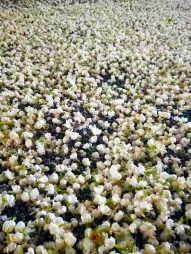With Valentine’s Day just around the corner, we’ve been getting into the spirit by brewing up some of our favorite floral tea blends. From classics like Jasmine Green and Lotus Blossom to newer favorites like The Rose Garden, there are teas for lovers of almost every kind of flower you can imagine. And as it turns out, the practice of using flowers to flavor tea blends is nearly as old and widespread as the art of tea itself.

Some of the earliest records we have on the use of floral infusions come from Persia, during the Sasanian Empire (224-651 CE). Although Persian royalty had long been known for their love of beautiful gardens, it was during this era that methods of steaming petals to make rosewater were perfected. Rosewater was soon used in everything from perfumes to cosmetics to medicinal decoctions, and its popularity spread throughout Europe, northern Africa, and western Asia. Ancient Greeks and Romans associated the flower with Aphrodite (also known as Venus) and like the Persians made broad use of the flower in almost every application imaginable. Roses continued to be used worldwide in folk remedies over the centuries, and with the introduction of tea culture into Europe it was only inevitable that the two would be combined. Western recipe books and home journals begin suggesting the additions of rose petals to tea blends by the early Victorian era, gaining special popularity around the turn of the 20th century. Today, rose petals are one of the most popular additions to teas of all types, as well as tisanes.

Across the world in China, tea merchants have been using jasmine flowers to scent and blend with green tea since the Song Dynasty (960-1279 CE). This era also saw the growing popularity of chrysanthemum teas and tisanes, as the lightly fragrant yellow blossom was prized not only for its medicinal properties but its sweet and delicate flavor. Chrysanthemum tea soon spread to Japan by the 5th century, and also to Korea, where it remains popular alongside other flower tisanes such as peach and plum blossom.
Two other flowers that are commonly seen in tea blends and tisanes are chamomile and lavender, both of which have long been thought to possess calming or sleep-inducing properties. Like roses, lavender and chamomile blossoms have been used for medicinal purposes since antiquity, with ancient physicians such as Dioscorides prescribing them for all sorts of ailments from indigestion to headaches. Preparing these blossoms for consumption by infusing them in boiling water was commonplace, and they were often paired with herbs like mint, sage, and rosemary for a more palatable and very fragrant tisane.
As all this history attests, flower petals and tea can make for delicious and beautiful combination. We especially love brewing floral tea in either a glass teapot or gaiwan to fully appreciate the appearance of the blossoms as they infuse. During a long and dreary winter, flower teas are just one small way to look forward to the coming days of spring.
By: Jen Coate













 Chinese history and traditions, which are thought to bring strength to the country as it undergoes rapid change and modernization. This focus on history brought puerh and puerh tea cakes to the top of the tea market. Not to lose ground, manufacturers of white and oolong teas began producing their own aged cakes to compete for the attention of the newly born middle class Chinese consumer. Using much the same technology as the puerh makers, these manufacturers are charting new territories in tea production, while still using the traditional methods.
Chinese history and traditions, which are thought to bring strength to the country as it undergoes rapid change and modernization. This focus on history brought puerh and puerh tea cakes to the top of the tea market. Not to lose ground, manufacturers of white and oolong teas began producing their own aged cakes to compete for the attention of the newly born middle class Chinese consumer. Using much the same technology as the puerh makers, these manufacturers are charting new territories in tea production, while still using the traditional methods.